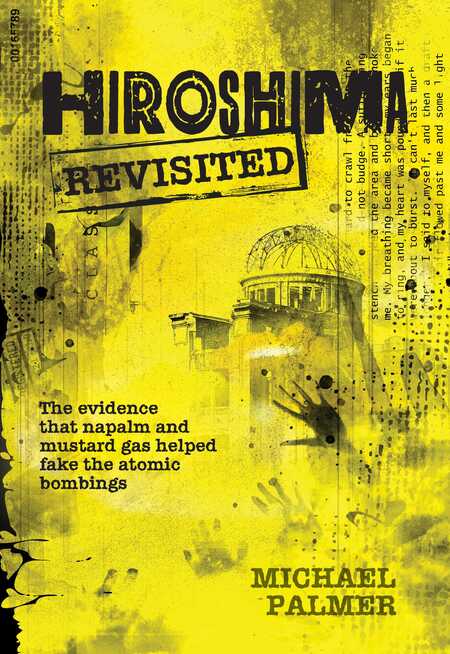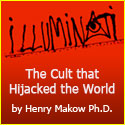Smoking Gun! No Nuclear Bombs Were Dropped on Japan
February 17, 2023
Scientific leaders of the Manhattan Project. Left to right:
Ernest O. Lawrence, Arthur H. Compton, Vannevar Bush, James B. Conant,
Karl T. Compton, and Alfred L. Loomis.
by Michael Palmer, MD
According to the history books, Hiroshima and Nagasaki were each destroyed by a single atomic bomb. The Hiroshima bomb contained uranium, and the Nagasaki bomb contained plutonium. A plutonium bomb is also said to have been detonated in the famous "Trinity" test explosion at Alamogordo in New Mexico on July 16, 1945.
Others and I have argued that these bombings were not atomic. While many of the arguments against the atomic nature of the bombings are rather technical, there is at least one clear and simple piece of evidence among US government declassified files.
In this document, none other than physics Nobel laureate Arthur Compton, who oversaw the Manhattan Project's entire physics research, stated on the record that shortly before the alleged atomic bombings, plutonium had not yet been purified, and that it would become available "in volume" only about three years later. Compton's statements contradict the official story of the alleged plutonium bombs at Alamogordo and at Nagasaki.
The story of how the "atomic age" began at Hiroshima and Nagasaki has been drummed into our heads so persistently that many readers will outright reject the notion that these atomic bombs were faked. Nevertheless, there is abundant evidence of the fakery [1-3].
 A short overview of my own work on the subject [3] has been posted here earlier, and a somewhat longer one can by found on my website. The purpose of this post is not to rehash all of it yet again, but merely to highlight one straightforward piece of evidence that might serve as a "gateway drug" for readers who are not ready to entertain the possibility that the nuclear bombings were indeed faked.
A short overview of my own work on the subject [3] has been posted here earlier, and a somewhat longer one can by found on my website. The purpose of this post is not to rehash all of it yet again, but merely to highlight one straightforward piece of evidence that might serve as a "gateway drug" for readers who are not ready to entertain the possibility that the nuclear bombings were indeed faked.
ARTHUR COMPTON AND THE "MANHATTAN PROJECT"
Arthur Holly Compton was an American atomic physicist and Nobel laureate who achieved fame early on in his career by discovering what is now known as Compton scattering. In this physical effect, a high-energy X-ray or γ-photon hits an electron straight on; it transfers some of its energy to this electron and then bounces off with diminished energy into a different direction. The electron will be yanked loose and sent flying. High-energy electrons generated in this manner contribute to the harmful effects of X- and γ-radiation on living beings [4].
Early on in the establishment of the "Manhattan Project"--the US-led effort to build atomic bombs during World War II--Compton was tasked with overseeing and coordinating all of the Project's physics research [5,6]. This involved the enrichment of uranium-235 (235U) for use in nuclear reactors and for bomb construction. It also included the construction of reactors and their use to convert uranium-238 (238U) to plutonium-239 (239Pu), which could then be used as an alternate bomb fuel. Compton was particularly keen on producing 239Pu, envisioning that it could be purified from the mixture of metals contained in the reactor fuel by chemical methods, which seemed more straightforward than the arduous physical enrichment of 235U to bomb grade.
The official narrative is that both 235U and 239Pu became available for bomb construction in the nick of time [5]. The first ever detonation of an atomic bomb is said to have occurred at Alamogordo, New Mexico, on July 16, 1945. Both this bomb and the one used at Nagasaki on August 9 are said to have contained 239Pu. In contrast, the Hiroshima bomb is said to have contained highly enriched 235U. As we will see, this official narrative is incompatible with Arthur Compton's own explicit admissions.
THE INTERIM COMMITTEE MEETING MAY 31 1945
The Interim Committee was a panel of leading scientists and politicians that was convened in 1945 to deliberate and advise on the future military and civilian use of atomic energy. Its affiliated scientific panel comprised leading physicists Robert Oppenheimer, Enrico Fermi, Arthur Compton, and Ernest Lawrence; all were present at the meeting in Washington, DC on May 31st, 1945. The following quote is taken from the protocol of this meeting [7]:
Dr. A. H. Compton explained the various stages of development. The first stage involved the separation of uranium 235. The second stage involved the use of 'breeder' piles to produce enriched materials from which plutonium ... could be obtained. ... It was estimated that from January 1946 it would take one and one-half years to prove this second stage in view of certain technical and metallurgical difficulties, that it would take three years to get plutonium in volume, and that it would take perhaps six years for any competitor to catch up with us.
The "technical and metallurgical difficulties" referred to by Compton most likely concern the purification of plutonium from the "enriched materials," which in this context means the complex mixture of radioactive elements resulting from the 235U fission chain reaction. Compton predicts that it will take about two years from the time of the meeting to work out this purification method, and that it will take another year to obtain plutonium "in volume." Even if we assume that "proving the second stage" will already provide enough plutonium for a small number of bombs, Compton's words still imply that two more years must pass before the first plutonium bomb can be assembled. Thus, the inference is unavoidable that a plutonium bomb could not possibly have been ready a mere six weeks later for the fabled test at Alamogordo, or for the bombing of Nagasaki three weeks after that--or even for the "Able" and "Baker" alleged nuclear bomb tests at the Bikini Atoll in 1946.
THE HISTORY OF THE DOCUMENT
The protocol of the meeting was initially classified "top secret" but must have been declassified sometime before 1995, because the pertinent quote can be found in the historic treatise "The decision to use the atomic bomb" by Alperovitz [8], which was published in 1995, and which is where I found it in 2020. (Apparently, neither the author nor his readers through the years had understood what it meant.) A Norwegian physicist with whom I had been corresponding pointed me to the full copy of the protocol at the National Security Archive. It has since been scrubbed from the NSA website, but the Wayback machine has preserved copy.
SUPPORTING EVIDENCE
Compton's estimate of the time of plutonium availability is supported by some intriguing findings from Nagasaki. Within the city, the highest levels of plutonium are found in a little body of water (the Nishiyama reservoir) located about three kilometres from the hypocenter of the detonation. Plutonium has been detected within in the sediment of this reservoir [9]. The same study also detected charcoal particles, which represent the soot from the burning city. Remarkably, however, the soot is contained in a deeper layer than the plutonium, and the distance between the two layers suggests that the plutonium was deposited in the reservoir approximately two years after the bombing.
Donald Collins was one of the "Manhattan Engineers" who carried out fallout measurements on the ground in Nagasaki several weeks after the bombing. In his recollections [10], he describes only rather low levels of radioactivity, and he does not mention the Nishiyama reservoir, which suggests that this reservoir did not yield any remarkable findings at the time.
Overall, we have it "from the horse's mouth" that at least the story of the plutonium bombs at Alamogordo and at Nagasaki is a fabrication. A fuller analysis of the evidence [2,3] proves the same for the Hiroshima bombing also.
References- The Atom Bomb Hoax
-
Björkman, A. (2023) My Atomic Bomb Findings: The grand manipulation 1945-2023.
-
Nakatani, A. (2017) Death Object: Exploding the Nuclear Weapons Hoax (CreateSpace).
-
Palmer, M. (2020) Hiroshima revisited: the evidence that napalm and mustard gas helped fake the atomic bombings.
-
Valota, A. et al. (2003) Modelling study on the protective role of OH radical scavengers and DNA higher-order structures in induction of single- and double-strand break by gamma-radiation. Int. J. Radiat. Biol. 79:643-53
-
Groves, L.R. (1962) Now it can be told (Harper & Row).
-
Hewlett, R.G. and Anderson, O.E. (1962) The New World, 1939/1946 / A History of the United States Atomic Energy Commission (Pennsylvania State University Press).
-
Arneson, R.G. (1945) Notes of the Interim Committee meeting, Thursday, 31 May 1945.
-
Alperovitz, G. (1995) The decision to use the atomic bomb (Alfred A. Knopf).
-
Saito-Kokubu, Y. et al. (2008) Depositional records of plutonium and 137Cs released from Nagasaki atomic bomb in sediment of Nishiyama reservoir at Nagasaki. J. Environ. Radioact. 99:211-7
-
Collins, D.L. (1980) Pictures from the past: Journeys into health physics in the Manhattan District and other diverse places in: Health Physics: a Backward Glance (Pergamon Press).






